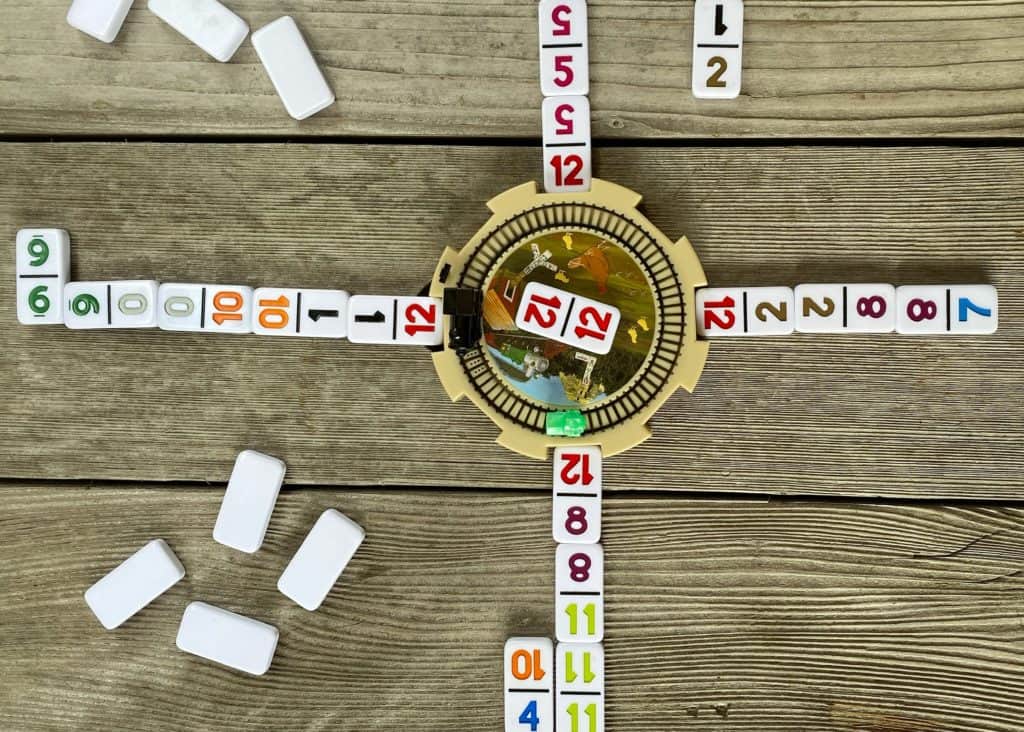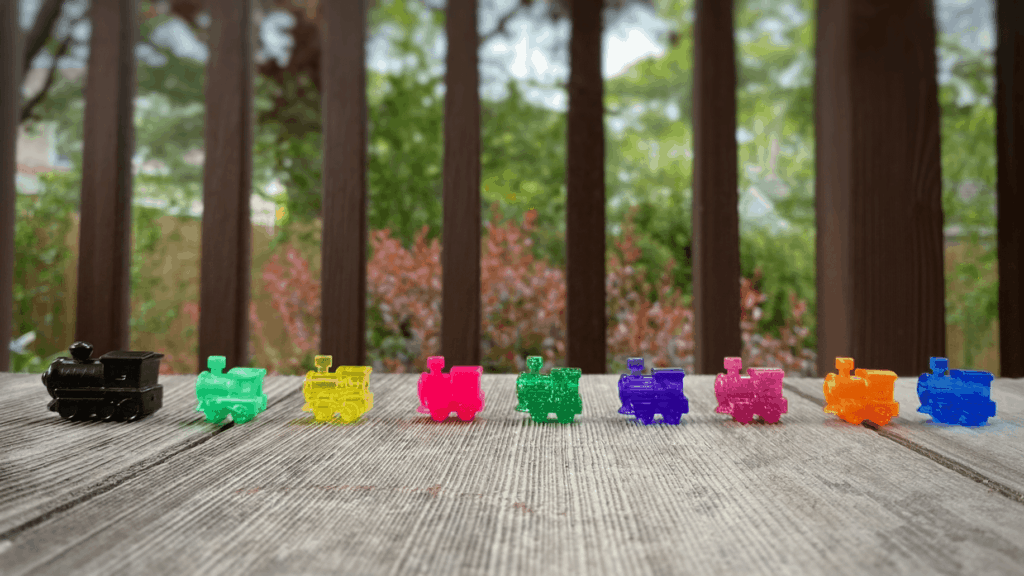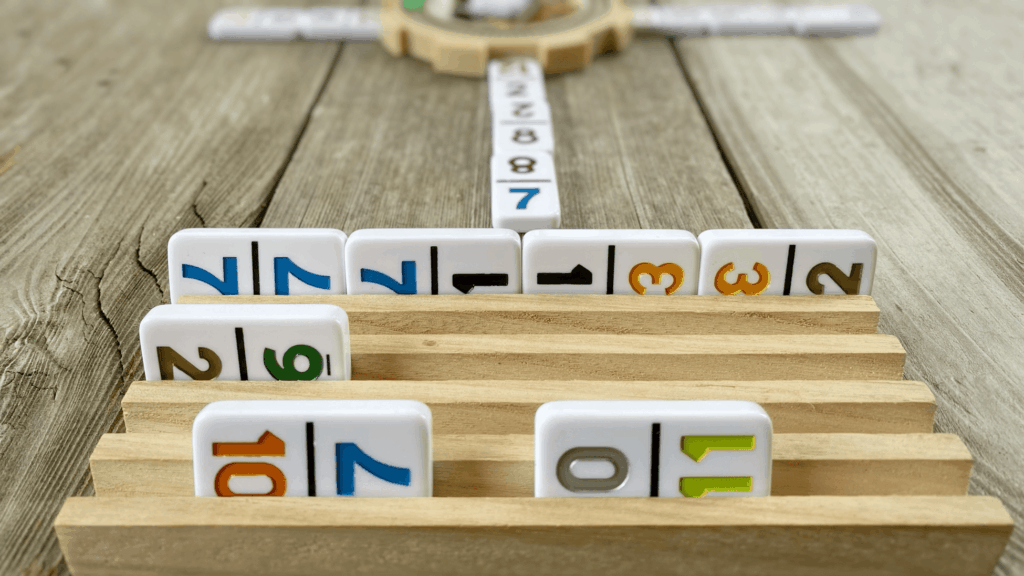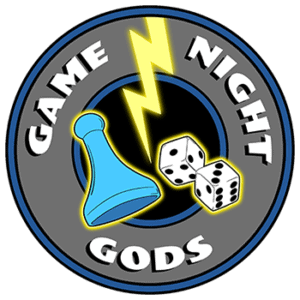We like to consider Mexican Train Dominoes as one of the tabletop games that re-ignited our family’s love for game night. Believe it or not, a few years back, we did not play board games as a family for quite a bit of time. Over recent years, our family has fallen in love with this game, making it one of our favorite table-top games. We’ll go over just how much we love this table-top game in our Mexican Train Dominoes review and strategy guide. We will also go over our Mexican Train Dominoes rules and how we play.
Before we dive in to our Mexican Train Dominoes review and strategy guide, here is a bit of a back story. My sister and I did the inevitable… we grew from children into adults; we were too busy with jobs, school, and hanging out with our friends.
We lost sight of staying home and hanging out as a family. However, as we got older and settled down into a routine, we realized how much we missed our family game nights.
We learned how to play Dominoes through our best friend’s grandmother. After going over her house a few times to play, we were hooked.
We looked at each other one day and decided that we needed to introduce our parents to Mexican Train Dominoes. Therefore, we bought a set of 12-sided Dominoes for Mexican Train of our own so that we could bring it over to the next family game night.
Ever since that day, we have been playing almost every weekend! It was the only game our parents wanted to play (until recently where they were up to trying some new games), and we never complained once. Why? Because we finally had our family time back!
What is Mexican Train Dominoes?
Mexican Train Dominoes is a game played with double sided numbered dominoes, where the objective of each round is to play all of the dominoes/tiles from your hand before other players do.
Players place their tiles on various chains or “trains” that emanate from a central hub or “train station.” Each player has their own train, however, there is a universal train that belongs to all players, called the “Mexican” train.

Mexican Train Dominoes Review & History
The rules for “The Train Game” were developed by a couple, Roy and Katie Parsons, in California in the early 90’s. After becoming more widely known, the Puremco Company purchased the rights for the game and turned it into the game we know and love today, Mexican Train Dominoes.
The premise of the game is believed to have been inspired by several Chinese Domino games including Tien Gow, also known as Heaven-Nine, Pai Gaw and Kap Tai.
Mexican Train also includes some “just for fun” features such as:
- Whenever a player starts their train a whistle blows
- When a double is played, hit two tiles together like a signal made by two trains passing on a double set of tracks
- When a player runs out of dominoes they can make a Choo Choo noise to announce their win of the round.
There are various versions of this beloved train game. We like to play the 12 double sided set which contains numbers varying up to 12. If you are playing with the double-twelve set, then there will be 12 rounds in total, starting with the double 12 and ending with the double 0. Other versions include double-six and double-nine.
How To Play Mexican Train Dominoes
In this Mexican Train Dominoes Review, we will go over how to set up your game, as well as, how to play! Stay tuned until the end and we will reveal some of our favorite strategies.
Equipment:
- Mexican Train Double 12 Dominoes set with dominoes, central hub, and train markers
- Wooden Domino Racks (optional, but recommended)

Set up:
- To start the first round, shuffle all of the dominoes face down on the table. Make sure they are mixed really well.
- If using, hand each player a domino rack, as well as their train marker (usually a different colored train shaped bead).
- Then, each of the players pick up dominoes from the mixed pile to add to their rack. In a double twelve set game, players draw dominoes as follows:
- 2–4 players: 15 dominoes each
- 5–6 players: 12 dominoes each
- 7–8 players: 10 dominoes each
- Any remaining dominoes are left face down and will be used throughout the game. Keep them out of the way in little piles near players.
Mexican Train Dominoes Rules
Check out our Mexican Train rules and gameplay below…
Gameplay:
- If you are playing with Double Twelve Dominoes, play begins with whoever picked up the double 12 domino from the initial pick from the mixed pile. If nobody happened to pick up the double twelve, then decide who goes first and begin taking turns picking up dominoes from the excess pile until someone has found the double twelve.
- The player who has or finds the double twelve starts by placing the double twelve in the center of the hub or “train station” and begins their train with a twelve domino. If they do not have a twelve to place down, they will have to pick up a tile from the extra pile. If it contains a twelve, then they must play that domino to start their train. If not, then they must keep that tile and play continues to the next player on the left. This player will then begin their train by either placing a domino from their rack, or drawing from the excess pile.
- The Mexican Train: this is a universal train that ANYONE can go on. It does not belong to a specific player. It is usually marked by a special train marker on the central hub.
- Each player takes turn placing tiles on their train, an opponents “public” train (more on this in a bit), or on the Mexican Train. A player can open up the Mexican train if they already have opened their own train. All players can place any of their tiles on the Mexican Train. The Mexican train must be opened with the number domino of which the round is on, just like you would start your own train.
- Dominoes on any train must be connected by corresponding numbers. For example, if I started my train with a 12 / 6 domino, then my next domino must contain a 6 in order to attach it to my train. So if I place a 6 / 2 domino, then my next domino must contain a 2. And so on!
- Players can opt to continue their train in front of them or go on the Mexican train. If a player cannot go on their own train OR the Mexican train AND draw a tile from the excess pile that cannot go anywhere, then they must place their little train in the central hub and they are considered “open.”
- Public Trains: When a player’s train is open, this means that anyone can go on this person’s train. Now players have the option to go on their own train, the Mexican train, or any public trains. A player’s train remains public until they are able to place one of their tiles on their own train to “close” it again. Once they are able to go on their own train and close it, they can remove their playing piece from the central hub and they are no longer considered a public train.
- Doubles: Tiles that are double-sided (for example 2 / 2 or 10 / 10) are played differently. When playing a double sided tile with the same number, you must place another tile with the same number immediately after the double is played. So if I play a 2 / 2 tile, then I must play a tile immediately after that contains a 2. If you place a double sided tile and cannot place another tile to close the double, then you will have to pick up a tile to see if you get a number that can be placed following the double. If the tile you picked up will not work, then you are considered “open.” However, t does not end here! A double must be closed before normal play can continue.
- If the player who placed the double cannot close it, then you will go around the table, one player at a time, until someone can place a corresponding number tile. If the next person cannot place a tile, then they draw another tile from the excess pile and either place it. If they do not pick up a tile that works, then the next person goes to try and close out the double. Continue until the double is closed. Here is a scenario: I play a double sided 2. I do not have another tile with a 2 on my rack. I pick up a domino from the excess pile and still do not have a 2. I am considered “open” and place my train to mark that my train is open. The next person must place a 2 on my train in order to close the double. They state that they do not have a 2 and they proceed to pick up another tile from the excess pile. This domino does not have a 2, therefore their turn is skipped and the next person goes (they do not have to open their train since they did not place the double in the first place). This person must still place a 2 on my train because the double is still open. They have a domino with the number 2 on their rack. They place it on my train and close out my double. Play continues on like normal.
- Something to note: the dominoes leftover from the beginning are used throughout the game. However, if the excess dominoes run out, then this is ok. You simply do not pick up a domino since there are none, and your turn is technically skipped.
- Dead Trains: a train is considered “dead” when no-one can place anything on the end of the train and no more excess tiles are left. Just ignore this train for the rest of the round as it cannot be used.
- The round ends when a player places all of their dominoes on the table with none left in front of them/on their rack.
- The remaining players count up their dominoes and tell their score to the scorekeeper. Make sure each player counts up both the numbers on every domino. The scorekeeper should write down in a notebook everyone’s score in order to keep track. There will be multiple rounds, so don’t try to memorize scores!
- The next round starts with the next number counting down from the last, in our case it would be the Double Eleven. Then after that round, the double ten, and so on.
- The whole game ends when the Double Zero round has finished.
- Scoring: The scorekeeper will then tallies up each players score from all of the rounds and the player with the lowest score wins! With the double 12 domino set, there will be 13 rounds in total.

How Long Does Mexican Train Dominoes Take To Play?
Through our experience playing the double 12 Mexican train dominoes, we have had games last usually between 2-3 hours. It really depends on the version you are playing, how many people, and how long it takes each player to think/play their hand.
With 5 players, a game of double 12 Mexican Dominoes takes about 3 hours to play.
Mexican Train Domino Strategies
When you play a game as much as we have played Dominoes, you start to pick up on certain ways that people play the game. Here are the three strategies we use most often to help us win!
#1 Planned & Organized:
This is the strategy that I (Kait) use! After picking up my tiles for a round, I immediately line them up on my tray and try to create the longest train. Be sure to try different combinations when you have multiple numbers that can line up, you never know what combo will create the longest train on your rack!
If there are any dominoes that don’t fit in my planned train, I place them at the bottom of my tray. When the round begins, I will be placing dominoes on my train from the planned train on my rack. If I have a lot of extra tiles that aren’t a part of my train, I will try and open up the “Mexican” train as soon as possible. If at any time I have an extra domino that can be placed on another train, I do so. The logic behind this is that I know I can place on my train at any time with the dominoes that I planned out, so I want to try and get rid of the extra dominoes as soon as possible!
The only time I WILL NOT place an extra domino on another train is if it is a double that I do not have a domino to close!!! This is just too risky for me, if I place a double down without a domino to back it up, I am forced to pickup a domino from the spare pile. If I am lucky, it will match the number that I need but if it doesn’t, now I must open up my train for the other players, essentially ruining my planned train!

#2 Risk It Chaos:
This is Branden’s Strategy. Although he uses some organization by planning out his train ahead of time, Branden relies on taking risks and causing chaos to win.
He will constantly play doubles without having a domino to back it up. He would rather risk opening up his train and get rid of a double as soon as possible (and hopefully mess someone else’s up in the process) than hold on to those pesky doubles! His way of playing doesn’t always work out in his favor, but we have found that his risk taking does pay off from time to time.
#3 Sneaky and High Roller:
In this strategy, you begin by laying out your train tiles on the rack and arrange them in a way where other players will not be able to tell how many tiles you have on your starting train. Try to use fake breaks so they do not think you have a continuous train. This can really throw them off!
This strategy really focuses on how you lay your tiles out in the beginning. You will find that there may be multiple options to use when laying out your tiles. If there are multiple options, then always try to use the higher number tiles first. Remember, at the end of the game, lowest scores wins. Therefore, during the game, always keep an eye on your higher tiles. If you can get rid of a higher tile at any time, do it.
Build a train with fewer tiles, but more points. Do not focus on the amount of tiles when building out your train. Rather, focus on the higher points and put them towards the beginning of your train if you can. Getting rid of higher point tiles is important because the round can end before you are able to get rid of all of your tiles. If you are left with low score tiles at the end of the round, then you should be in good shape to win!
Mexican Train Dominoes Review
If you follow us on instagram, you will see that we play Mexican Train Dominoes quite frequently! It is a family favorite game of members of all ages in our household. With simple rules and strategies, it’s an easy game to learn and play.
We love playing dominoes on our patio during the summer months, it’s a very relaxing game to play outdoors after a long week of work.

